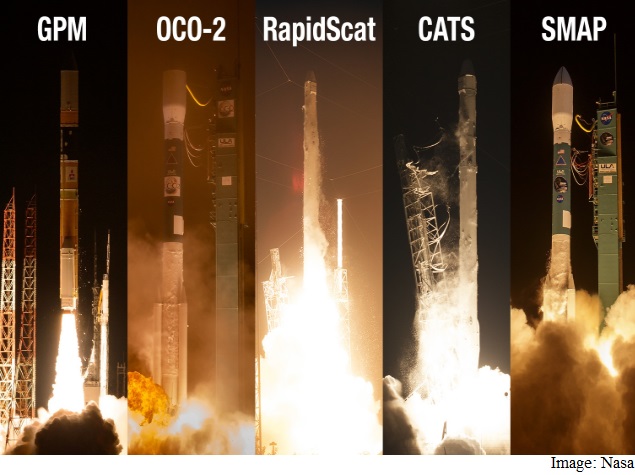- Home
- Science
- Science News
- New Nasa Earth Missions Exploring Our Complex Planet
New Nasa Earth Missions Exploring Our Complex Planet

On February 27 last year, Nasa and the Japan Aerospace Exploration Agency (JAXA) successfully launched the Earth-observing Global Precipitation Measurement (GPM) Core Observatory into space from Japan.
Nasa's newest Earth-observing satellite, the Soil Moisture Active Passive (SMAP), was launched Jan 31 this year to begin its mission to map global soil moisture and detect whether soils are frozen or thawed.
Data from GPM and the other new missions are making observations and providing scientists with new insights into global rain and snowfall, atmospheric carbon dioxide, ocean winds, clouds and tiny airborne particles called aerosols, the US space agency said in a statement.
"This has been a phenomenally productive year for Nasa in our mission to explore our complex planet from the unique vantage point of space," said John Grunsfeld, associate administrator of Nasa's Science Mission Directorate in Washington, DC.
Combined with data from our other Earth-observing spacecraft, these new missions will give us new insights into how Earth works as a system, he added.
With these missions, including two instruments mounted on the exterior of the International Space Station (ISS), Nasa now has 20 Earth-observing space missions in operation.
Observations from these missions, like all Nasa data, will be freely available to the international scientific community.
"The highly accurate measurements from these new missions will help scientists around the world tackle some of the biggest questions about how our planet is changing," said Peg Luce, deputy director of the Earth Science Division at Nasa Headquarters in Washington, DC.
In addition to free-flying satellite missions, Nasa deployed two Earth-observing instruments to the ISS.
These are ISS-RapidScat, a scatterometer that measures wind speeds and direction over the ocean and the Cloud-Aerosol Transport System (CATS) that measures the altitude of clouds and airborne particles.
For the latest tech news and reviews, follow Gadgets 360 on X, Facebook, WhatsApp, Threads and Google News. For the latest videos on gadgets and tech, subscribe to our YouTube channel. If you want to know everything about top influencers, follow our in-house Who'sThat360 on Instagram and YouTube.
Related Stories
- Samsung Galaxy Unpacked 2025
- ChatGPT
- Redmi Note 14 Pro+
- iPhone 16
- Apple Vision Pro
- Oneplus 12
- OnePlus Nord CE 3 Lite 5G
- iPhone 13
- Xiaomi 14 Pro
- Oppo Find N3
- Tecno Spark Go (2023)
- Realme V30
- Best Phones Under 25000
- Samsung Galaxy S24 Series
- Cryptocurrency
- iQoo 12
- Samsung Galaxy S24 Ultra
- Giottus
- Samsung Galaxy Z Flip 5
- Apple 'Scary Fast'
- Housefull 5
- GoPro Hero 12 Black Review
- Invincible Season 2
- JioGlass
- HD Ready TV
- Laptop Under 50000
- Smartwatch Under 10000
- Latest Mobile Phones
- Compare Phones
- Oppo A5 Pro 5G
- Vivo Y29 5G
- Honor Magic 7 RSR Porsche Design
- Moto G15 Power
- Moto G15
- Realme 14x 5G
- Poco M7 Pro 5G
- Poco C75 5G
- Asus Zenbook S 14
- MacBook Pro 16-inch (M4 Max, 2024)
- Honor Pad V9
- Tecno Megapad 11
- Redmi Watch 5
- Huawei Watch Ultimate Design
- Sony 65 Inches Ultra HD (4K) LED Smart TV (KD-65X74L)
- TCL 55 Inches Ultra HD (4K) LED Smart TV (55C61B)
- Sony PlayStation 5 Pro
- Sony PlayStation 5 Slim Digital Edition
- Blue Star 1.5 Ton 3 Star Inverter Split AC (IC318DNUHC)
- Blue Star 1.5 Ton 3 Star Inverter Split AC (IA318VKU)

















